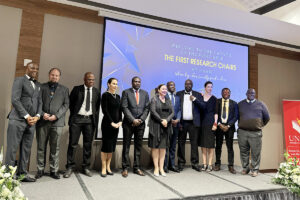The University of Namibia received a second High Performance Computing (HPC) rack from the Centre of High Performance Computing (CHPC), South Africa. The delivery was facilitated by the National Commission on Research Science and Technology (NCRST). CHPC is responsible for the distribution and deployment of decommissioned HPC hardware as mid-tier systems to research institutions within Africa under the HPC SADC Ecosystems project.
Initiated in the context of astrophysics, the current focus of the project is to support development of HPC in the Square Kilometre Array (SKA) and African Very Long Baseline Interferometry Network (AVN) partner countries across Africa, by enabling computational research initiatives and developing human capacity in HPC, both for administration and data- and computing-intensive research.
HPC (also referred to as supercomputing), generally refers to the practice of aggregating computing power of several computing nodes in a way that delivers much higher performance than one could be achieving by a typical desktop computer in order to solve large problems in business, science, or engineering.
The first HPC rack, code-named “Ranger”, was delivered to UNAM in 2016 and is operational ever since. It has 768 CPU cores with 1.5 Terabyte of RAM and 384 Gigabyte of storage. The newly received HPC rack, code-named the “Stampede” comes with a total of 640 CPU cores, 1.2 Terabyte of RAM and 10 Terabyte of storage. The Stampede HPC rack will be set-up and configured in the near future, effectively doubling available computing resources.
The Supercomputers are hosted by the Department of Physics in UNAM’s Faculty of Science building, but also cater for interdisciplinary computational research needs beyond astrophysics. Since its inception in 2017, the Ranger HPC rack has been used for various projects like the “Land Degradation Assessment Baseline report: Omusati Region” by the Department of Geography, History and Environmental Studies Geo-Information Science (GIS) unit in conjunction with GIZ and the Ministry of Agriculture, Water and Forestry.

In the Department of Physics, PhD and MSc projects on modelling the broadband emission of globular clusters and analyses of gamma-ray data of active galactic nuclei, recorded with the H.E.S.S. telescopes, are conducted. The Ranger HPC rack has also been used by masters and honours students in the School of Computing, undertaking final year projects which require greater computational power than an average laptop or desktop computer. The Department of Chemistry and Biochemistry is in the process of migrating some of the computation that the department is currently running on CHPC’s Lengau cluster to the UNAM HPC cluster.
To date, the Ranger HPC rack has run close to 500 jobs by more than 50 active users.
The Faculty of Science plans to host various trainings and workshops geared towards creating awareness in HPC. The HPC unit further encourages researchers who are already undertaking computational research at other HPC sites like CHPC’s Lengau cluster, to make use of the UNAM HPC site.
For more information or viewing the HPC racks, contact:
Dr Michael Backes mbackes@unam.na | Anton S. Limbo alimbo@unam.na
Jimmy Shapopi jimzashapopi@yahoo.com | Meinolf Simbenda msimbenda@unam.na





